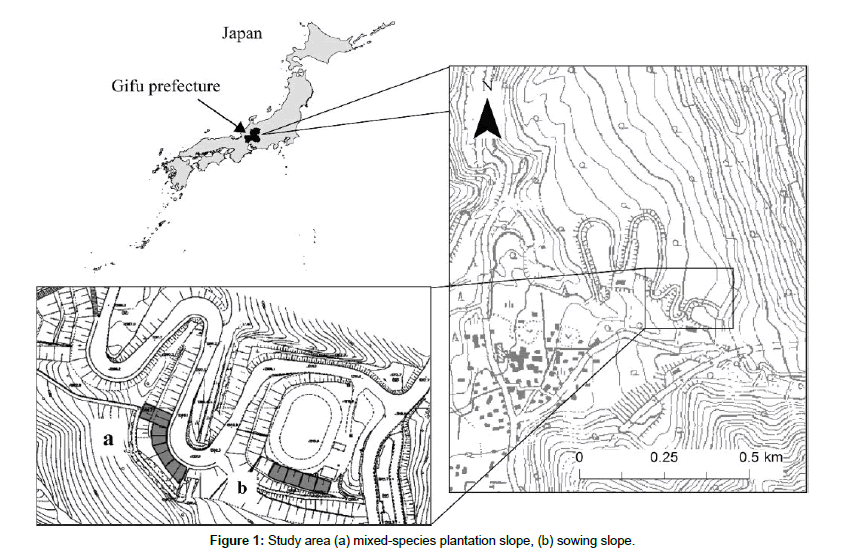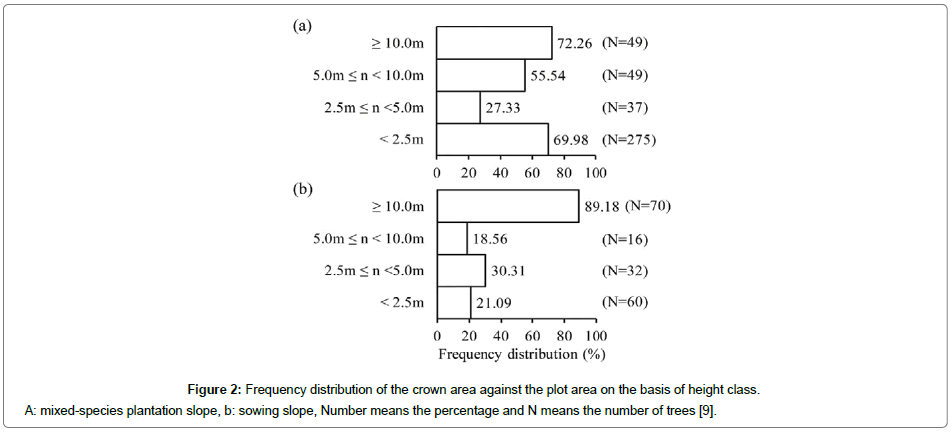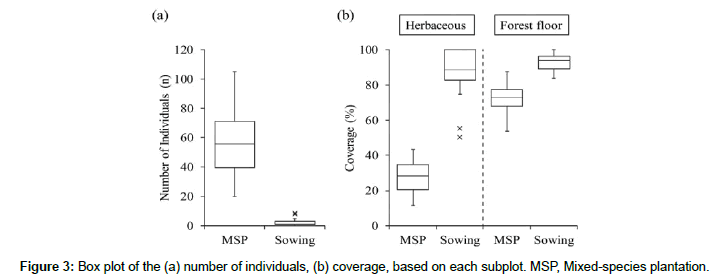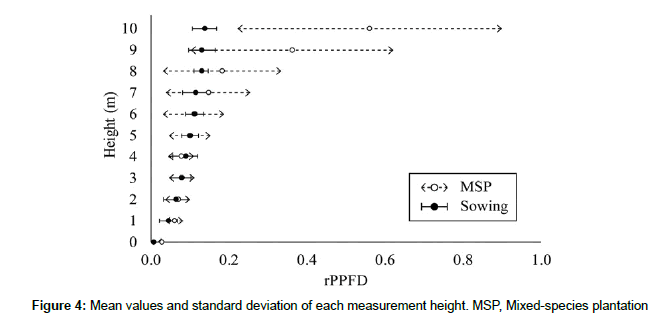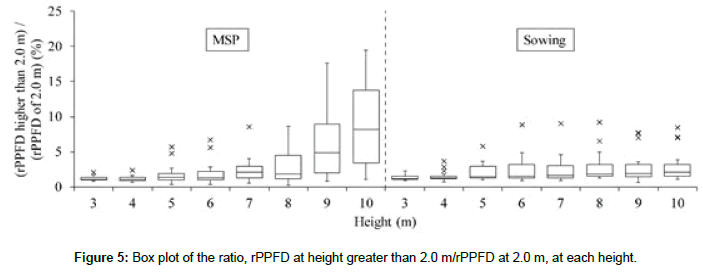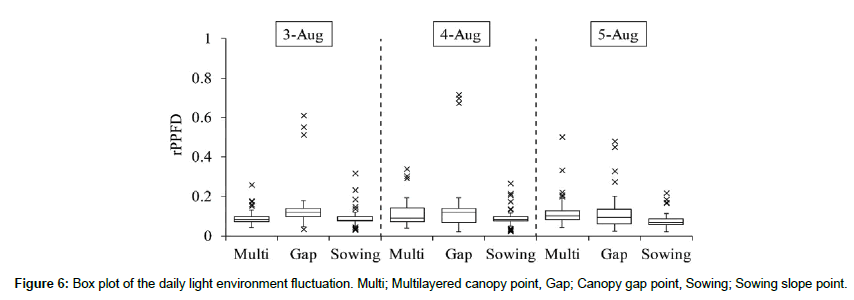Research Article, J Biodivers Manage Forestry Vol: 6 Issue: 2
Differences in the Light Environment at Different Heights between Monolayered Sowing Slope and Multilayered Mixed-Species Plantation Slope
Chiho Shimada1,2*, Keiko Nagashima1, Kennichi Takada3 and Kazuhiro Tanaka1
1Graduate school of Life and Environmental Sciences, Kyoto Prefectural University, Hangi-cho, Shimogamo, Sakyo-ku, Kyoto 606-8522, Japan
2Research Fellow of Japan Society for the Promotion of Science
3Center for Restoration of Regional Nature, Koyamahori-ike-cho, Kita-ku, Kyoto 603-8145, Japan
*Corresponding Author : Chiho Shimada
Graduate school of Life and Environmental Sciences, Kyoto Prefectural University, Hangi-cho, Shimogamo, Sakyo-ku, Kyoto 606-8522, Japan
Tel: +81-75-703-5635
E-mail: chiho.s.466@gmail.com
Received: July 03, 2017 Accepted: July 18, 2017 Published: July 24, 2017
Citation: Shimada C, Nagashima K, Takada K, Tanaka K (2017) Differences in the Light Environment at Different Heights between Monolayered Sowing Slope and Multilayered Mixed-Species Plantation Slope. J Biodivers Manage Forestry 6:2. doi: 10.4172/2327-4417.1000180
Abstract
Objective:
To maintain a sustainable forest, the existence of saplings plays an important role. The light environment is one of the most important parameters influencing the forest floor vegetation. To restore a natural forest, two techniques were introduced 25 years ago on a slope in the Akandana parking lot,
Japan: a mixed-species plantation method and a sowing method. The mixed-species plantation slope is a multilayered forest where the number of saplings was abundant, whereas the sowing slope is a monolayered forest where the dominance of herbaceous species and less number of saplings were confirmed. The purpose of this study was to determine the differences in the light environment at different heights as well as the daily fluctuation in the light conditions between the two slopes, and to decipher the influence of the light environment on the forest floor vegetation, especially on the saplings.
Methods:
We established 36 plots (5 m × 5 m) and measured relative photosynthetic photon flux density (rPPFD) at 1.0-m height intervals (using the midpoints) from 0.0 to 10.0 m. To continuously measure the fluctuation in the daily light environment for three days, one sensor was placed inside a typical point of the sowing slope and two sensors were placed inside the mixed-species plantation slope, one under the canopy gap point and one under the multilayered canopy.
Results:
The rPPFD at 0.0 m height on the sowing slope was significantly lower than that on the other slope because of the dominance of herbaceous species which hindered sapling establishment (P < 0.01). Moreover, the multilayered mixed-species plantation slope showed a wide variation in rPPFD in vertical and horizontal directions, whereas the monolayered sowing slope showed a uniform value.
Conclusion:
These findings suggest that the forest created by mixed-species plantation is more appropriate to be called a sustainable forest.
Keywords: Light environment; Sapling; Mixed-species plantation; Seed sowing; Multilayered forest; Monolayered forest
Introduction
Deforestation is believed to significantly affect several aspects of the environment, such as global warming, ecosystem, landscape, and disasters [1-3]. Therefore, restoration of areas that have been deforested has become an important issue in forest management. The need for restoring the target forest type cannot be overstated. For maintaining a sustainable forest, saplings play an important role [4].
Although several factors are assumed to influence the forest floor vegetation, Kato and Komiyama [5] suggested that light environment is one of the most important parameters. Other studies have also demonstrated that forest floor vegetation is affected by the light environment [6], which results in variations in the species found on the forest floors [7].
In a previous study [8,9], we investigated two types of standstructured forests-a multilayered forest established by mixed-species plantation and a monolayered forest established by seed sowing-and discussed the relationship between the light environment and the saplings. To determine the light environment, we calculated the “sky factor” using the hemispherical photographs taken from two heights, viz., 0.5 and 2.5 m, and found that the sky factor of the multilayered mixed-species plantation slope was significantly lower than that of the monolayered sowing slope at both the heights. Moreover, we did not find any significant difference in the sky factor at two heights on the sowing slope. With regard to the forest floor vegetation, significantly more number of saplings (3.2 individuals/m2) was confirmed on the mixed-species plantation slope compared to that on the sowing slope (0.1 individuals/m2). More than 70% of the study site was covered mainly by herbaceous species on the sowing slope whereas the coverage was about 20% on the mixed-species plantation slope. No significant correlation was found between the sky factor and the number of seedlings or species at different heights and on the two slopes. Mizui et al., Shimano et al. and Nakagawa et al. [10-12] reported that overgrowth of the understory vegetation, including herbaceous species, made the forest floor dark, which disturbed the emergence of seedlings. In addition, Shimano et al. [11] demonstrated that the number of individuals or species of saplings was highest at a place where light, attenuated by the overlapping canopy, reached the forest floor. Moreover, Baldocchi et al. and Guariguata et al. [13,14] reported that a multilayered forest would lead to high diversity in the light environment, and Nagaike [15] suggested that species would coexist if fluctuation in the amount and quality of the light environment is high. Based on these reports, it was suggested that heights of 0.5 and 2.5 m were not enough for addressing the relationship between the light environment and saplings. For proper comprehension, additional light environment on the forest floor as well as the vertical and daily distribution of light on both the slopes was required.
The present study was, therefore, conducted to clarify the differences in the light environment by considering more variations of heights and daily fluctuation between the two slopes and to decipher the influence of the light environment on the saplings, which are important to maintain a sustainable forest.
Methods
Study area
The study was conducted on a slope in the Akandana parking lot (1,300 m a.s.l.) in Takayama city, Gifu prefecture, Japan (Figure 1). The average temperature (based on data collected from 1981 to 2010) and average precipitation in Takayama city are 11.0 degrees Celsius and 1,699.5 mm/year [16], respectively; thus, the area receives snowfall and is cold. No vegetation survived the construction of the parking lot, even though the area is a part of the Chubu-Sangaku National Park. It was necessary to restore the natural forest rapidly, giving consideration to the landscape, as well. Therefore, a method of mixed-species plantation was introduced over the entire slope, except in one area where seeds were sown in the period from 1990 to 1992. Mixed-species plantation method is a method wherein different seral stage saplings suitable to the conditions prevailing at the site are planted to restore a natural forest composed of many species with a multilayered forest structure in a short period of time [17,18].
In the mixed-species plantation slope, several layers were detected, composed mainly of planted trees with a species distribution pattern preserved from the time of planting [8] (Table 1a, Figure 2). These layers included a tree layer, composed of Betula ermanii Cham., Betula platyphylla Sukatchev var. japonica (Miq.) Hara, and Quercus crispula Blume, a sub-tree layer, composed mainly of Sorbus commixta Hedl., and a shrub layer, composed mainly of Taxus cuspidata Sieb. et Zucc. and Weigela hortensis (Sieb. et Zucc.) K. Koch. In contrast, on the sowing slope, a monolayer, i.e., a tree layer composed of Alnus hirsuta Turcz. var. sibirica (Fischer) C.K. Schn., with a random distribution was detected [8] (Table 1b, Figure 2).
Figure 2: Frequency distribution of the crown area against the plot area on the basis of height class.
A: mixed-species plantation slope, b: sowing slope, Number means the percentage and N means the number of trees [9].
| Species | Number | Height (m) | DBH (cm) | |||||||
|---|---|---|---|---|---|---|---|---|---|---|
| 25% | 50% | 75% | 25% | 50% | 75% | |||||
| Planted | Betula ermanii Cham | 54 | (51) | 9.3 | 10.4 | 11.5 | 9.4 | 10.9 | 13.7 | |
| Betula platyphylla Sukatchev var. japonica (Miq. ) Hara | 21 | (18) | 8.9 | 10.3 | 13.7 | 9.3 | 11.3 | 15.9 | ||
| Quercus crispula Blume | 44 | (20) | 1.2 | 3.9 | 7.8 | 0.0 | 4.9 | 10.9 | ||
| Sorbus commixta Hedl | 39 | (29) | 1.9 | 2.5 | 3.8 | 1.0 | 1.5 | 2.8 | ||
| Taxus cuspidate Sieb. et Zucc | 27 | 1.5 | 1.8 | 2.1 | 1.2 | 1.7 | 2.3 | |||
| Weigela hortensis (Sieb. et Zucc. ) K. Koch | 137 | 0.9 | 1.2 | 1.5 | 0.0 | 0.0 | 1.0 | |||
| Non-planted | 16 species | 88 | 0.8 | 1.0 | 1.3 | 0.0 | 0.0 | 0.1 | ||
| Total | 410 | |||||||||
Table 1(a): Data of the investigated trees (a) Mixed-species plantation slope.
| Species | Number | Height (m) | DBH (cm) | ||||||
|---|---|---|---|---|---|---|---|---|---|
| 25% | 50% | 75% | 25% | 50% | 75% | ||||
| Sown | Alnus hirsuta Turcz. var. sibirica(Fischer) C.K.Schn | 94 | (80) | 9.1 | 13.3 | 15.0 | 10.1 | 13.6 | 16.2 |
| Non-sown | 16 species | 84 | 1.4 | 2.0 | 3.0 | 0.5 | 1.4 | 2.9 | |
| Total | 178 | ||||||||
Table 1(b): Sowing slope
The investigation was conducted at the same place where a previous study was conducted from 2012 to 2013 [8,9]. The study site had 5 plots (10 × 10 m) on the mixed-species plantation slope and 4 on the sowing slope (Figure 1). Owing to the two slopes being adjacent, a comparative study was made feasible because the following three conditions were same: the surrounding vegetation (a primeval forest, composed by Abies homolepis Sieb. et Zucc., B. ermanii, Cercidiphyllum japonicum Sieb. et Zucc., Chamaecyparis pisifera (Siebold et Zucc.) Endl., Fagus crenata Blume, and T. cuspidata Sieb. et Zucc., and a coppice forest, composed mainly of Q. crispula Blume), the direction (southwest), and the slope angle (29°).
Data collection and analysis
To correlate the current light environment and the forest floor vegetation, we investigated the forest floor vegetation in August 2016. We divided the plots into 5 × 5 m subplots (20 subplots on the mixedspecies plantation slope and 16 on the sowing slope) and recorded the following two coverage types on each subplot, below the height of 1.8 m (the height of the herbaceous layer):
Total coverage composed of tree and herbaceous species,
Coverage of every herbaceous species.
The number of individuals of each sapling species was also recorded. To compare the forest floor vegetation between the two slopes, we performed t-test for total coverage, coverage of herbaceous species, and number of sapling individuals.
To determine the light environment, we measured the photosynthetic photon flux density (referred to as PPFD, hereafter) using a quantum sensor (LI-190R, Li-Cor Inc., Lincoln, Neb.) at 1.0- m height intervals (using the midpoints of the subplot) from 0.0 m to 10.0 m. We used a 1.0-m interval carbon pole (total length, 10.0 m) and attached the quantum sensor on the top. The measurement points were same as in our previous investigation, wherein we estimated the light environment using the hemispherical photographs. The measurement was taken in July 2016, on an overcast day. To calculate the relative photosynthetic photon flux density (referred to as rPPFD, hereafter), one sensor was left in an open space and every 10-s averages were measured automatically. All the collected data were stored in data-loggers (LI-1500G, Li-Cor Inc., Lincoln, Neb.). To assess the differences in the light environment in a vertical distribution between the two slopes, we calculated the mean value and the standard deviation for each height. We then performed the t-test for each height between the two slopes. In addition, the Steel-Dwass multiple comparison test was performed between 0.0 and 10.0 m. Moreover, we focused on the light environment at the 2.0 m height (the height just above the herbaceous layer), which is considered to influence the herbaceous layer, and calculated the ratio, rPPFD at height greater than 2.0 m/rPPFD at 2.0 m, at each height from 3.0 m to 10.0 m, to determine the influence of the light environment above 2.0 m.
To measure the daily fluctuation in the light environment, one sensor was placed inside a typical point of sowing slope and two sensors were placed inside the mixed-species plantation slope, one under canopy gap point and one under multilayered canopy. The measurement heights were all 1.0 m and data was collected from August 3 to 5, 2016 between sunrise and sunset (05:00 to 19:00 h). The weather was partly cloudy through the three days. The quantum sensor and the data-logger were the same as in the vertical light environment survey and data were collected for every 10-s average. To check the difference in the daily fluctuation between each measurement points through the three days, we calculated the 15-min average and then compared the daily fluctuation.
Results
From the forest floor vegetation survey (data are shown in Appendix 1 and 2), the number of saplings per m2 on the multilayer slope was 2.29 (total 1,145 individuals from 35 species), which was more than the sapling density (0.07) on the monolayer slope (total 26 individuals composed of 11 species) (P < 0.01). The box plot also shows the difference in the number of saplings between the two slopes (Figure 3). A significant difference was also noted in the forest floor coverage (P < 0.01): the coverage was 72.2% on the mixed-species plantation slope and 93.0% on the sowing slope. The coverage of herbaceous species was also significantly different (P < 0.01): the mean coverage was 27.9% (composed of 64 species) on the mixed-species plantation slope and 87.0% (composed of 51 species) on the sowing slope (Figure 3). Therefore, small difference in the forest floor coverage between the two slopes and a large difference in the coverage of the herbaceous species were confirmed. Moreover, on the sowing slope, small difference between the coverage of forest floor and herbaceous species was also confirmed.
From 20 measurement points on the mixed-species plantation slope and 16 points on the sowing slope, significant differences (P < 0.01) between the two slopes were only observed at three heights, viz., 0.0, 9.0, and 10.0 m (Table 2). This suggests that the two slopes had a similar light environment except at few heights; however, the minimum and maximum rPPFD values were 0.008 and 1.000 for the mixed-species plantation slope, and 0.002 and 0.217 for the sowing slope. The mean value and standard deviation at each height demonstrates that the mixed-species plantation slope had a wide variety of light environments in both the vertical and horizontal directions, whereas the light environment on the sowing slope was more uniform (Table 2, Figure 4). This tendency was also observed in the results of the multiple comparisons; sowing slope had no significant differences at heights more than 5.0 m whereas mixedspecies plantation slope had a significant difference at higher heights (Table 3). In addition, the box plot showing the variation in rPPFD at height greater than 2.0 m/rPPFD at 2.0 m also indicated a wide variation in the light environment of mixed-species plantation slope whereas less variation was observed on the sowing slope (Figure 5).
| Height (m) | Mean value ± standard deviation | P value | ||||
|---|---|---|---|---|---|---|
| MSP slope | Sowing slope | |||||
| 0 | 0.027 | 0.011 | 0.006 | 0.003 | P < 0.01 | |
| 1 | 0.060 | 0.023 | 0.045 | 0.023 | 0.075 | |
| 2 | 0.070 | 0.032 | 0.064 | 0.032 | 0.610 | |
| 3 | 0.079 | 0.032 | 0.077 | 0.025 | 0.804 | |
| 4 | 0.077 | 0.032 | 0.088 | 0.031 | 0.308 | |
| 5 | 0.099 | 0.053 | 0.101 | 0.021 | 0.897 | |
| 6 | 0.110 | 0.078 | 0.112 | 0.023 | 0.922 | |
| 7 | 0.147 | 0.108 | 0.114 | 0.033 | 0.220 | |
| 8 | 0.182 | 0.152 | 0.129 | 0.018 | 0.144 | |
| 9 | 0.362 | 0.260 | 0.130 | 0.034 | P < 0.01 | |
| 10 | 0.560 | 0.338 | 0.137 | 0.030 | P < 0.01 | |
Table 2: Mean values and standard deviation of each measurement height.
| Height (m) | 0 | 1 | 2 | 3 | 4 | 5 | 6 | 7 | 8 | 9 | 10 |
|---|---|---|---|---|---|---|---|---|---|---|---|
| 0 | - | - | - | - | - | - | - | - | - | - | - |
| 1 | ** | - | - | - | - | - | - | - | - | - | - |
| 2 | ** | - | - | - | - | - | - | - | - | - | |
| 3 | ** | - | - | - | - | - | - | - | - | ||
| 4 | ** | - | - | - | - | - | - | - | |||
| 5 | ** | - | - | - | - | - | - | ||||
| 6 | ** | - | - | - | - | - | |||||
| 7 | ** | ** | - | - | - | - | |||||
| 8 | ** | ** | * | * | - | - | - | ||||
| 9 | ** | ** | ** | ** | ** | ** | * | - | - | ||
| 10 | ** | ** | ** | ** | ** | ** | ** | ** | * | - |
Table 3a: Result of the multiple comparison test between 0.0 and 10.0 m (Mixedspecies plantation slope).
| Height (m) | 0 | 1 | 2 | 3 | 4 | 5 | 6 | 7 | 8 | 9 | 10 |
|---|---|---|---|---|---|---|---|---|---|---|---|
| 0 | - | - | - | - | - | - | - | - | - | - | - |
| 1 | ** | - | - | - | - | - | - | - | - | - | - |
| 2 | ** | - | - | - | - | - | - | - | - | - | |
| 3 | ** | - | - | - | - | - | - | - | - | ||
| 4 | ** | * | - | - | - | - | - | - | - | ||
| 5 | ** | ** | * | - | - | - | - | - | - | ||
| 6 | ** | ** | ** | * | - | - | - | - | - | ||
| 7 | ** | ** | * | * | - | - | - | - | |||
| 8 | ** | ** | ** | ** | ** | * | - | - | - | ||
| 9 | ** | ** | ** | ** | * | - | - | ||||
| 10 | ** | ** | ** | ** | ** | * | - | ||||
| **: P < 0.01, *: P < 0.05 | |||||||||||
Table 3b: Sowing slope.
The box plot of daily light environment shows that sowing slope had the smallest daily fluctuation over the three days when the measurement was made, whereas the canopy gap point showed the largest width (Figure 6). The multilayered canopy showed medium width, whereas not much difference was observed between the canopy gap points on August 4 (Figure 6).
Discussion
As observed in our previous study [8], the present study on forest floor vegetation revealed that the coverage by herbaceous species was significantly higher on the sowing slope. The small difference between the coverage of forest floor and the herbaceous species on the sowing slope indicates the dominance of the herbaceous species. Moreover, the number of the saplings was significantly lower on the sowing slope. Because rPPFD of the forest floor (0.0 m) was significantly lower on the sowing slope (Table 2), as reported by Mizui et al., Shimano et al. and Nakagawa et al. [10-12], we propose that the dominance of the herbaceous species hindered the sapling establishment on the sowing slope. In contrast, on the mixed-species plantation slope, the high value of the forest floor coverage compared to the herbaceous species coverage could be considered to have been caused by the understory tree vegetation. Because the level of light on the forest floor (0.0 m) was higher than that on the sowing slope, as reported by Shimano et al. [11], it is considerable to believe that the light, which was attenuated by the overlapping canopy (not only the understory tree vegetation but also the vegetation on the upper heights), supported the existence of the saplings.
No significant difference in rPPFD was found between the two slopes at 2.0 m height, which is considerable for influencing the herbaceous layer. Therefore, we cannot conclude that the light environment at 2.0 m affected the forest floor vegetation. Moreover, no significant difference in rPPFD was found between the two slopes at other heights, except at 9.0 and 10.0 m (Table 2). These results suggest that the two slopes had a similar light environment except at a few heights. However, the rPPFD at height greater than 2.0 m/rPPFD at 2.0 m ratio showed a clear difference between the two slopes; the ratio increased with the height at which rPPFD was measured on the mixed-species plantation slope whereas the fluctuation in the ratio at different heights were small on the sowing slope (Figure 5). Moreover, the standard deviation in rPPFD for each height varied with increasing height on the mixed-species plantation slope but took a constant-breath on the sowing slope (Figure 4). In addition, the results of the multiple comparisons revealed that on the sowing slope, rPPFD was similar at heights more than 5.0 m, whereas a significant difference was found with increasing height on the mixed-species plantation slope (Table 3). These results suggest that a multilayered forest established by mixed-species plantation has a wide variation in the light environment for vertical and horizontal directions, whereas a monolayered forest established by sowing has uniformity in the light environment. It is interesting that no significant difference was found in the rPPFD values between the two slopes at 2.0 m, whereas a difference in the variety was confirmed by measuring at more heights, which has a high possibility for causing the difference in the forest floor vegetation.
The variation in the light environment on the mixed-species plantation slope is expected to be wider on sunny days. Chazdon [19] and Chazdon et al. [20] reported the importance of sunflecks for understory plants, which fluctuates during the day. Measuring the daily fluctuation under sunny and partly cloudy days in this study, the daily fluctuation in the ascending order was: point at the sowing slope, the multilayered canopy point, the canopy gap point. The last two points were measured on the mixed-species plantation slope. This order was same through the three measurement days. We had only measured at one or two points on each slope; however, because the two measurement points on the mixed-species plantation slope showed a different fluctuation tendency, it is conceivable that the daily fluctuation is larger inside a multilayered forest, which shows a high possibility of having a wide variety in sunflecks. Therefore, there is a high possibility of difference inside the forest between the two slopes in daily fluctuation (possibly called sunflecks) at 1.0 m, whereas no significant difference was found for an instantaneous value on an overcast day. Because significant difference was also not found at 2.0 m height, it is conceivable that the difference in sunflecks will also be found at 2.0 m, which might be related to the difference in the forest floor vegetation. On the other hand, seasonal variability is another conceivable factor in the influence of light environment on the forest floor vegetation. In a deciduous forest, the time of foliation and defoliation are different for each species [21,22], and these differences exhibit a seasonal variability, which is said to heavily influence the forest floor light environment [23,24]. Therefore, at our study site, where the species composition and the stand structure was different between the two slopes, this seasonal variability is conceivable to be one of the parameters responsible for the difference in the forest floor vegetation.
In our previous study, wherein we estimated the light environment from the hemispherical photographs taken from 0.5 and 2.5 m, the mixed-species plantation slope was darker than the sowing slope [9]. However, as revealed in the present study, no significant difference was found from the rPPFD values between the two slopes at similar heights, i.e., 1.0, 2.0, and 3.0 m. Although the years of recording the data were different, the discordance between rPPFD and the light environment estimated from the hemispherical photographs, supports other reports, which indicates the difficulty in estimating rPPFD using hemispherical photography, especially under overlapping canopy [6,25-27].
In conclusion, the main findings of our study are as follows: Firstly, an rPPFD at 0.0 m on the sowing slope was significantly lower than on the other slope because of the dominance of herbaceous species, which hindered sapling establishment; secondly, no significant difference was observed in the rPPFD values between the two slopes just above the herbaceous layer, whereas the multilayered mixedspecies plantation slope showed a wide variety in rPPFD for vertical and horizontal directions, where monolayered sowing slope had uniformity; thirdly, it is speculated that multilayered mixed-species plantation slope had a wide variation in sunflecks, as well, whereas monolayered sowing slope had less variation, which could possibly influence the forest floor vegetation. Overall, rPPFD showed a wide variety in a multilayered forest where the saplings were abundant, whereas rPPFD was uniform in a monolayered forest where the dominance of herbaceous species and less number of saplings were confirmed. Therefore, the former forest created by mixed-species plantation is more appropriate to be called a sustainable forest.
Acknowledgments
This work was supported by JSPS Grant-in-Aid for JSPS Research Fellow Grant Numbers 15J06305.
References
- Chiba Y (2015) Forest Ecosystem Function and Future Challenges for Global Warming. Journal of the Surface Science Society of Japan 36: 263-264.
- FAO (2011) Assessing Forest Degradation: Towards the Development of Globally Applicable Guidelines. Food and Agriculture Organization, Rome, Italy.
- Miles L, Kapos V (2008) Reducing greenhouse gas emissions from deforestation and forest degradation: Global land-use implications. Science 320: 1454-1455.
- Masaki T, Sato T, Sugita H, Tanaka N, Yagihashi T, et al. (2012) Density and Size of Saplings Required for the Successful Regeneration after Clear cutting of Deciduous Forests: An Analysis Based on the Long-term Monitoring Data of Mt Naeba Experimental Beech Forest. J Jpn For Soc 94: 17-23.
- Kato S, Komiyama A (1999) Distribution patterns of understory trees and diffuse light under the canopy of a beech forest. Japanese Journal of Ecology 49: 1-10.
- Machado JL, Reich PB (1999) Evaluation of several measures of canopy openness as predictors of photosynthetic photon flux density in deeply shaded conifer-dominated forest understory. Can J For Res 29: 1438-1444.
- Canham CD, Finzi AC, Pacala SW, Burbank DH (1994) Causes and consequences of resource heterogeneity in forests: interspecific variation in light transmission by canopy trees. Can J For Res 24: 337-349.
- Shimada C, Nagashima K, Sakakibara N, Takada K, Tanaka K (2015) The differences of the community structure established in 20 years between the sowing slope and the natural planting slope. J Jpn Soc Reveget Tech 40: 547-554.
- Shimada C, Nagashima K, Takada K, Tanaka K (2017) The differences of the light environment established in 20 years between the monolayered sowing slope and the multilayered mixed-species plantation slope. J For Plann 22: 15-21.
- Mizui N, Kikuzawa K, Asai T (1979) Studies on the natural regeneration of artihical Todo-fir (Abies sachalinensis) Stand Germination and mortality of seedlings during four years. Bulletin of the Hokkaido Forest Experiment Station 17: 13-22.
- Shimano K, Ikeda T, Wada M (2001) Relationship among forest structure, species composition, light condition, and seedling distribution on a series of succession. Rept Inst Nat Stu 33: 127-152.
- Nakagawa M, Ohno Y, Yamada K, Nagasaka Y, Yasaka M (2009) Comparison of soil properties and biodiversity among forest types 2: understory vegetation. Bulletin of the Hokkaido Forestry Research Institute 46: 137-144.
- Baldocchi D, Collineau S (1994) The physical nature of solar radiation in heterogeneous canopies: spatial and temporal attributes. Academic Press, San Diego.
- Guariguata MR, Rheingnas R, Montagnini F (1995) Early woody invasion under tree plantations in Costa Rica: Implications for forest restoration. Restoration Ecology 3: 252-260.
- Nagaike T (2000) A review of ecological studies on plant species diversity in plantation ecosystems. J Jpn For Soc 82: 407-416.
- Japan Meteorological Agency (2013) Past weather data.
- Takada K (1999) Shizenhaishoku-ryokka no kihontekina kangaekata. Kyoto College of art 22: 127-139.
- Shimada C, Nagashima K, Takada K, Tanaka K (2013) Primary stage of slope revegetated by planting different seral stage broadleaved trees. J Jpn Soc Reveget Tech 39: 422-428.
- Chazdon RL (1988) Sun flecks and their importance to forest understory plants. Ad Ecol Res 18: 1-63.
- Chazdon RL, Pearcy RW (1991) The importance of sunflecks for forest understory plants. Bio Science 41: 760-766.
- Kikuzawa K (1983) Leaf survival of woody plants in deciduous broad-leaved forests, 1. Tall trees. Can J Bot 61: 2133-2139.
- Kato S, Yamamoto M, Komiyama A (1999) Leaf phenology of over-and understory trees in a deciduous broad-leaved forest: An observation at the Mumai plot in 1997. Jpn J For Environment 41: 39-44.
- Anderson MC (1964) Studies of the woodland light climate II: Seasonal variation in the light climate. J Ecol 52: 643-663.
- Baldocchi D, Hutchison B, Matt D, McMillen R (1984) Seasonal variations in the radiation regime within an oak-hickory forest. Agric Forest Meteorol 33: 177-191.
- Ishida M (2000) Effects of light condition on distribution and shoot extension in regenerated trees of the main species in Japanese temperate forests. Journal of the Toyama Forestry and Forest Products Research Center 13: 1-96.
- Ishida M (2004) Automatic thresholding for digital hemispherical photography. Can J For Res 34: 2208-2216.
- Kunizaki T (2002) Estimation of relative photon flux density within stands of conifer/deciduous broad-leaved mixtures. Bulletin of the Iwate University Forests 33: 1-10.
 Spanish
Spanish  Chinese
Chinese  Russian
Russian  German
German  French
French  Japanese
Japanese  Portuguese
Portuguese  Hindi
Hindi 